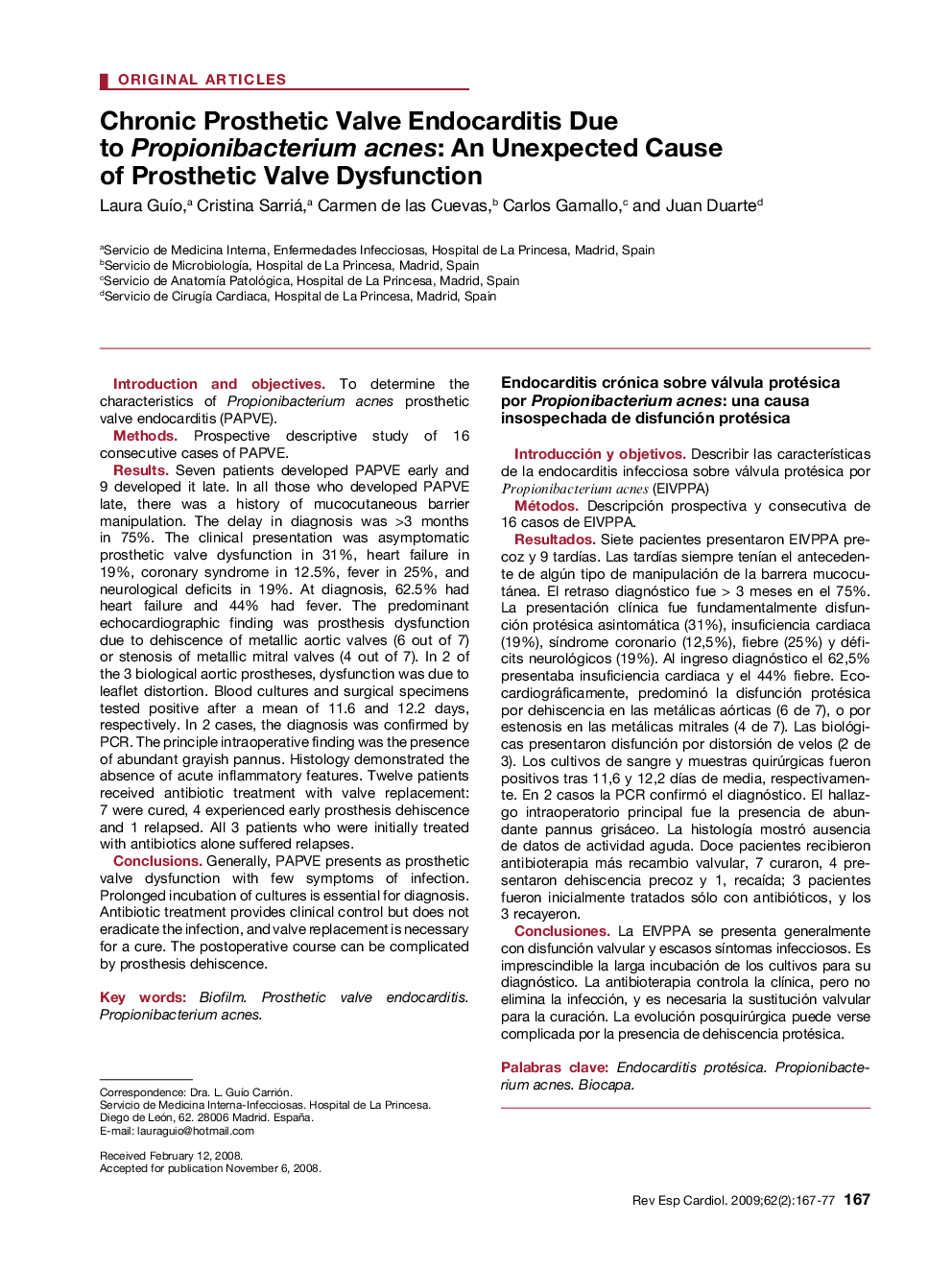| Article ID | Journal | Published Year | Pages | File Type |
|---|---|---|---|---|
| 3019163 | Revista Española de Cardiología (English Edition) | 2009 | 11 Pages |
Introduction and objectivesTo determine the characteristics of Propionibacterium acnes prosthetic valve endocarditis (PAPVE).MethodsProspective descriptive study of 16 consecutive cases of PAPVE.ResultsSeven patients developed PAPVE early and 9 developed it late. In all those who developed PAPVE late, there was a history of mucocutaneous barrier manipulation. The delay in diagnosis was >3 months in 75%. The clinical presentation was asymptomatic prosthetic valve dysfunction in 31%, heart failure in 19%, coronary syndrome in 12.5%, fever in 25%, and neurological deficits in 19%. At diagnosis, 62.5% had heart failure and 44% had fever. The predominant echocardiographic finding was prosthesis dysfunction due to dehiscence of metallic aortic valves (6 out of 7) or stenosis of metallic mitral valves (4 out of 7). In 2 of the 3 biological aortic prostheses, dysfunction was due to leaflet distortion. Blood cultures and surgical specimens tested positive after a mean of 11.6 and 12.2 days, respectively. In 2 cases, the diagnosis was confirmed by PCR. The principle intraoperative finding was the presence of abundant grayish pannus. Histology demonstrated the absence of acute inflammatory features. Twelve patients received antibiotic treatment with valve replacement: 7 were cured, 4 experienced early prosthesis dehiscence and 1 relapsed. All 3 patients who were initially treated with antibiotics alone suffered relapses.ConclusionsGenerally, PAPVE presents as prosthetic valve dysfunction with few symptoms of infection. Prolonged incubation of cultures is essential for diagnosis. Antibiotic treatment provides clinical control but does not eradicate the infection, and valve replacement is necessary for a cure. The postoperative course can be complicated by prosthesis dehiscence.
Introducción y objetivosDescribir las características de la endocarditis infecciosa sobre válvula protésica por Propionibacterium acnes (EIVPPA)MétodosDescripción prospectiva y consecutiva de 16 casos de EIVPPA.ResultadosSiete pacientes presentaron EIVPPA precoz y 9 tardías. Las tardías siempre tenían el antecedente de algún tipo de manipulación de la barrera mucocutánea. El retraso diagnóstico fue > 3 meses en el 75%. La presentación clínica fue fundamentalmente disfunción protésica asintomática (31%), insuficiencia cardiaca (19%), síndrome coronario (12,5%), fiebre (25%) y déficits neurológicos (19%). Al ingreso diagnóstico el 62,5% presentaba insuficiencia cardiaca y el 44% fiebre. Ecocardiográficamente, predominó la disfunción protésica por dehiscencia en las metálicas aórticas (6 de 7), o por estenosis en las metálicas mitrales (4 de 7). Las biológicas presentaron disfunción por distorsión de velos (2 de 3). Los cultivos de sangre y muestras quirúrgicas fueron positivos tras 11,6 y 12,2 días de media, respectivamente. En 2 casos la PCR confirmó el diagnóstico. El hallazgo intraoperatorio principal fue la presencia de abundante pannus grisáceo. La histología mostró ausencia de datos de actividad aguda. Doce pacientes recibieron antibioterapia más recambio valvular, 7 curaron, 4 presentaron dehiscencia precoz y 1, recaída; 3 pacientes fueron inicialmente tratados sólo con antibióticos, y los 3 recayeron.ConclusionesLa EIVPPA se presenta generalmente con disfunción valvular y escasos síntomas infecciosos. Es imprescindible la larga incubación de los cultivos para su diagnóstico. La antibioterapia controla la clínica, pero no elimina la infección, y es necesaria la sustitución valvular para la curación. La evolución posquirúrgica puede verse complicada por la presencia de dehiscencia protésica.
